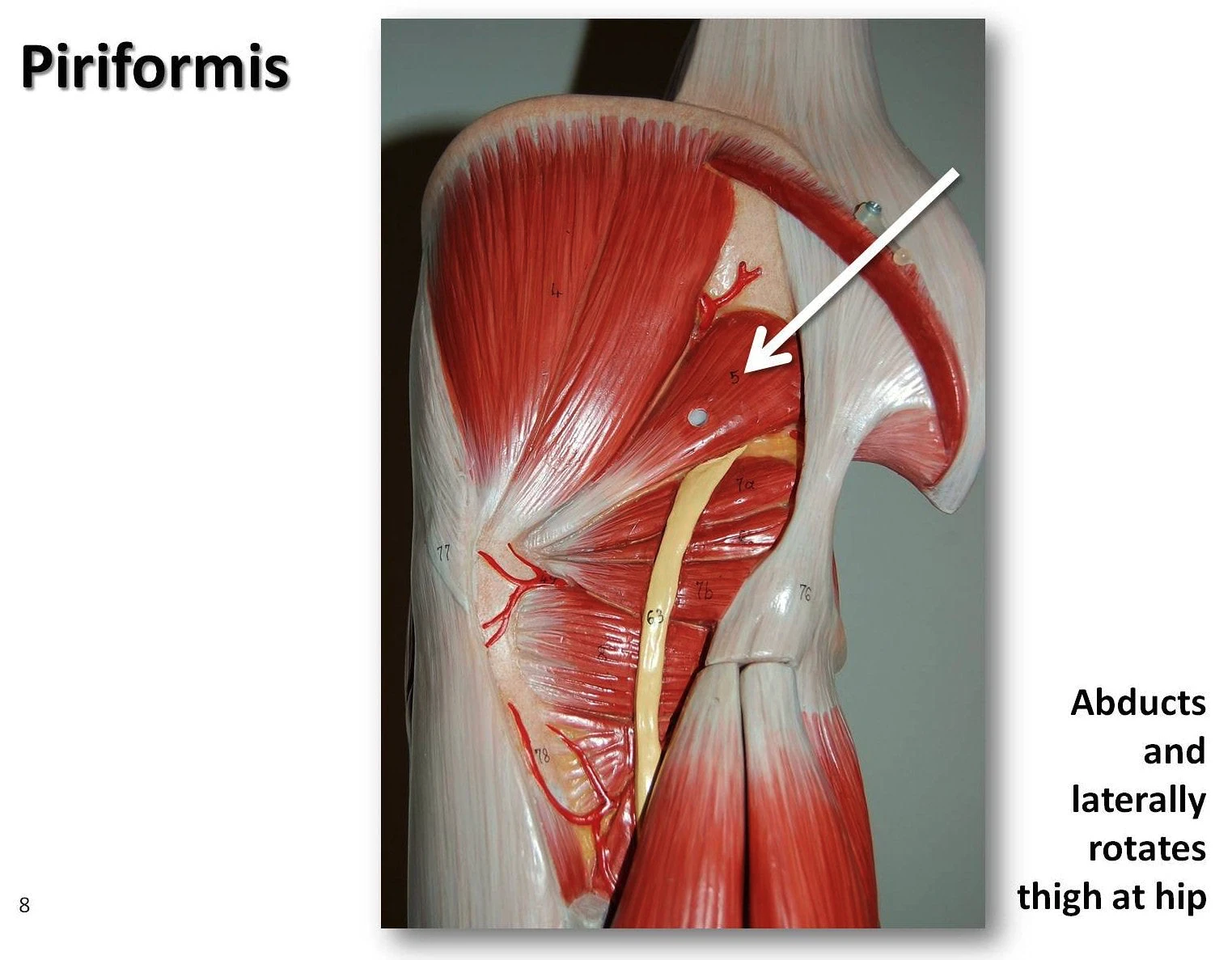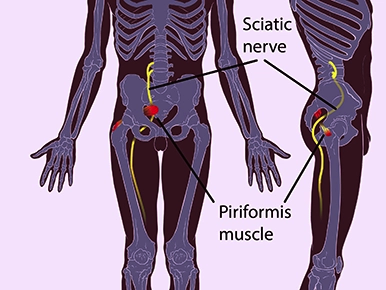Acupuncture treatment of piriformis syndrome and sciatica
Acupuncture treatment and Chinese Herbal Medicine consultations in South West London, SW14, SW15, SW18, SW19, Earlsfields, Southfields and Wimbledon
Call 07720773890 now for more information and to book your free 15 minutes consultation
Sciatica is the name given to any sort of pain that is caused by irritation or compression of the sciatic nerve.
Many people confuse general back pain with sciatica. The difference between sciatica and general back pain is that the pain of sciatica is not just limited to your back, but also stretches down your buttocks and into your legs.
If you have sciatica, you may have some numbness or muscle weakness in your legs and feet. Some people also experience a tingling sensation ('pins and needles') in their feet.
The sciatic nerve
The sciatic nerve is the longest nerve in your body. It runs from the back of your pelvis, through your buttocks, and all the way down both legs, ending at your feet.
Anything that compresses or irritates the sciatic nerve can cause a pain that radiates out from your lower back, down your leg to your calf.
Sciatic pain can range from being mild to being very painful.
Sciatica can have a number of causes, such as a herniated disc (often referred to as a slipped disc). In many cases of sciatica, there is no obvious cause. It is thought that a combination of muscle, joint and bone strain may lead to sciatica.
Many people confuse general back pain with sciatica. The difference between sciatica and general back pain is that the pain of sciatica is not just limited to your back, but also stretches down your buttocks and into your legs.
If you have sciatica, you may have some numbness or muscle weakness in your legs and feet. Some people also experience a tingling sensation ('pins and needles') in their feet.
The sciatic nerve
The sciatic nerve is the longest nerve in your body. It runs from the back of your pelvis, through your buttocks, and all the way down both legs, ending at your feet.
Anything that compresses or irritates the sciatic nerve can cause a pain that radiates out from your lower back, down your leg to your calf.
Sciatic pain can range from being mild to being very painful.
Sciatica can have a number of causes, such as a herniated disc (often referred to as a slipped disc). In many cases of sciatica, there is no obvious cause. It is thought that a combination of muscle, joint and bone strain may lead to sciatica.
There are two types of sciatica:
Acute sciatica: lasts up to 6 weeks.
Chronic sciatica: lasts longer than 6 weeks.
Acute sciatica
Most cases of acute sciatica can be treated successfully and rapidly with acupuncture; the pain relief is often immediate: you feel better at the end of the first session
Conventional treatment of sciatica:
Painkillers Over-the-counter painkillers are usually effective in relieving symptoms of pain. The type of painkiller known as nonsteroidal anti-inflammatory drugs (NSAIDs), such as ibuprofen, is thought to work best.
Ibuprofen is usually recommended rather than aspirin because there is less chance of adverse side effects.
NSAIDs may not be suitable if you have asthma, high blood pressure, liver disease, heart disease or a history of stomach and digestive disorders. In these circumstances, paracetamol would probably be a more suitable painkiller for you.
If your sciatica symptoms are very severe, your GP may prescribe a muscle relaxant, such as diazepam. Diazepam can make you feel very sleepy so if you have been prescribed this medication you should not drive at all.
Acute sciatica: lasts up to 6 weeks.
Chronic sciatica: lasts longer than 6 weeks.
Acute sciatica
Most cases of acute sciatica can be treated successfully and rapidly with acupuncture; the pain relief is often immediate: you feel better at the end of the first session
Conventional treatment of sciatica:
Painkillers Over-the-counter painkillers are usually effective in relieving symptoms of pain. The type of painkiller known as nonsteroidal anti-inflammatory drugs (NSAIDs), such as ibuprofen, is thought to work best.
Ibuprofen is usually recommended rather than aspirin because there is less chance of adverse side effects.
NSAIDs may not be suitable if you have asthma, high blood pressure, liver disease, heart disease or a history of stomach and digestive disorders. In these circumstances, paracetamol would probably be a more suitable painkiller for you.
If your sciatica symptoms are very severe, your GP may prescribe a muscle relaxant, such as diazepam. Diazepam can make you feel very sleepy so if you have been prescribed this medication you should not drive at all.
Chronic sciatica
Treating chronic sciatica will probably require a combination of acupuncture and osteopathy
Self help for sciatica
Exercise If you have sciatica it is important for you to remain as physically active as possible. While bed rest may provide some temporary pain relief, prolonged bed rest will actually make your sciatica symptoms worse. Recommended exercises include walking and gentle stretching exercises.
Compression packs Many people find that using either hot or cold compression packs helps to reduce pain. You can make you own cold compression pack by wrapping a package of frozen food in a towel. Hot compression packs are usually available from larger pharmacies. You may find it helpful to use one type of pack after another.
Exercise and physical therapy. As with acute sciatica, if you have chronic sciatica you should try to remain as physically active as possible because this will reduce the severity of your symptoms.
It is also recommended that you continue to work or return to work as soon as possible.
Regular exercise will help to strengthen the muscles that support your back. Exercise also promotes the production of endorphins, which are natural pain killing chemicals.
Treating chronic sciatica will probably require a combination of acupuncture and osteopathy
Self help for sciatica
Exercise If you have sciatica it is important for you to remain as physically active as possible. While bed rest may provide some temporary pain relief, prolonged bed rest will actually make your sciatica symptoms worse. Recommended exercises include walking and gentle stretching exercises.
Compression packs Many people find that using either hot or cold compression packs helps to reduce pain. You can make you own cold compression pack by wrapping a package of frozen food in a towel. Hot compression packs are usually available from larger pharmacies. You may find it helpful to use one type of pack after another.
Exercise and physical therapy. As with acute sciatica, if you have chronic sciatica you should try to remain as physically active as possible because this will reduce the severity of your symptoms.
It is also recommended that you continue to work or return to work as soon as possible.
Regular exercise will help to strengthen the muscles that support your back. Exercise also promotes the production of endorphins, which are natural pain killing chemicals.
Can acupuncture help with piriformis syndrome?
Acupuncture can bring instant relief to piriformis syndrome, by releasing the spasm and contraction of the piriformis muscle, and tension in the lower back and surrounding area, electroacupuncture is particurlary effective for this condition.
The piriformis syndrome is a condition in which the piriformis muscle irritates the sciatic nerve, causing pain in the buttocks and referring pain along the course of the sciatic nerve. This referred pain, called "sciatica", often goes down the back of the thigh and/or into the lower back. Patients generally complain of pain deep in the buttocks, which is made worse by sitting, climbing stairs, or performing squats.
The piriformis muscle is one of the external rotators of the hip and leg. This means that as the muscle works, it helps to turn the foot and leg outward. Problems in the piriformis muscle can cause problems with the sciatic nerve. This is because the sciatic nerve runs under (and sometimes through) the piriformis muscle on its way out of the pelvis. The piriformis muscle can squeeze and irritate the sciatic nerve in this area, leading to the symptoms of sciatica.
What causes this problem?
The symptoms of sciatica come from irritation of the sciatic nerve. It's still a mystery why the piriformis muscle sometimes starts to irritate the sciatic nerve. Many doctors think that the condition begins when the piriformis muscle goes into spasm and tightens against the sciatic nerve, squeezing the nerve against the bone of the pelvis.
In some cases, the muscle may be injured due to a fall onto the buttock. Bleeding in and around the piriformis muscle forms a hematoma. A hematoma describes the blood that has pooled in that area. The piriformis muscle begins to swell and put pressure on the sciatic nerve. Soon the hematoma dissolves, but the muscle goes into spasm.
The sciatic nerve stays irritated and continues to be a problem. Eventually the muscle heals, but some of the muscle fibers inside the piriformis muscle are replaced by scar tissue. Scar tissue is not nearly as flexible and elastic as normal muscle tissue. The piriformis muscle can tighten up and put constant pressure against the sciatic nerve.
The piriformis muscle is one of the external rotators of the hip and leg. This means that as the muscle works, it helps to turn the foot and leg outward. Problems in the piriformis muscle can cause problems with the sciatic nerve. This is because the sciatic nerve runs under (and sometimes through) the piriformis muscle on its way out of the pelvis. The piriformis muscle can squeeze and irritate the sciatic nerve in this area, leading to the symptoms of sciatica.
What causes this problem?
The symptoms of sciatica come from irritation of the sciatic nerve. It's still a mystery why the piriformis muscle sometimes starts to irritate the sciatic nerve. Many doctors think that the condition begins when the piriformis muscle goes into spasm and tightens against the sciatic nerve, squeezing the nerve against the bone of the pelvis.
In some cases, the muscle may be injured due to a fall onto the buttock. Bleeding in and around the piriformis muscle forms a hematoma. A hematoma describes the blood that has pooled in that area. The piriformis muscle begins to swell and put pressure on the sciatic nerve. Soon the hematoma dissolves, but the muscle goes into spasm.
The sciatic nerve stays irritated and continues to be a problem. Eventually the muscle heals, but some of the muscle fibers inside the piriformis muscle are replaced by scar tissue. Scar tissue is not nearly as flexible and elastic as normal muscle tissue. The piriformis muscle can tighten up and put constant pressure against the sciatic nerve.


Chronic and acute sciatica and Piriformis syndrome are often treated successfully with a short course of acupuncture treatment the clinical evidence is very strong, and the acupuncture treatment of back pain, (lower back pain is the main cause of sciatica ) is endorsed by NICE The National Institute for Health and Clinical Excellence
Here is an extract from the The World Health Organization's ACUPUNCTURE: REVIEW AND ANALYSIS OF REPORTS ON CONTROLLED CLINICAL TRIALS:
2.1.2 Locomotor system
Chronically painful conditions of the locomotor system accompanied by restricted movements of the joints are often treated with acupuncture if surgical intervention is not necessary. Acupuncture not only alleviates pain, it also reduces muscle spasm, thereby increasing mobility. Joint damage often results from muscle malfunction, and many patients complain of arthralgia before any
Acupuncture: review and analysis of controlled clinical trials
changes are demonstrable by X-ray. In these cases, acupuncture may bring about a permanent cure. Controlled studies on common diseases and conditions in this category have been reported by different authors, with favourable results for acupuncture treatments compared with standard therapy, delayed-treatment controls, control needling, mock TENS, or other sham acupuncture techniques. The conditions concerned include cervical spondylitis or neck pain due to other causes (33–37), periarthritis of the shoulder (38, 39) fibromyalgia (40), fasciitis (41), epicondylitis (tennis elbow) (42–44), low back pain (45–49), sciatica (50–53), osteoarthritis with knee pain (54–56), and radicular and pseudoradicular pain syndromes (57). In some reports, comparison was made between standard care and acupuncture as an adjunct to standard care. The conclusion from one such randomized controlled trial was that acupuncture is an effective and judicious adjunct to conventional care for patients with osteoarthritis of the knee (58)
2.1.2 Locomotor system
Chronically painful conditions of the locomotor system accompanied by restricted movements of the joints are often treated with acupuncture if surgical intervention is not necessary. Acupuncture not only alleviates pain, it also reduces muscle spasm, thereby increasing mobility. Joint damage often results from muscle malfunction, and many patients complain of arthralgia before any
Acupuncture: review and analysis of controlled clinical trials
changes are demonstrable by X-ray. In these cases, acupuncture may bring about a permanent cure. Controlled studies on common diseases and conditions in this category have been reported by different authors, with favourable results for acupuncture treatments compared with standard therapy, delayed-treatment controls, control needling, mock TENS, or other sham acupuncture techniques. The conditions concerned include cervical spondylitis or neck pain due to other causes (33–37), periarthritis of the shoulder (38, 39) fibromyalgia (40), fasciitis (41), epicondylitis (tennis elbow) (42–44), low back pain (45–49), sciatica (50–53), osteoarthritis with knee pain (54–56), and radicular and pseudoradicular pain syndromes (57). In some reports, comparison was made between standard care and acupuncture as an adjunct to standard care. The conclusion from one such randomized controlled trial was that acupuncture is an effective and judicious adjunct to conventional care for patients with osteoarthritis of the knee (58)
Pj Cousin is a full member of the British Acupuncture Council and of the Unified Register of herbal Practitioners
Acupuncture at Cure by Nature
95 Replingham Road, London SW18 5LU
Tel: 07720773890
For a map Click here
Appointment available weekdays only
95 Replingham Road, London SW18 5LU
Tel: 07720773890
For a map Click here
Appointment available weekdays only
Traditional Chinese Medicine (TCM)
is one of the oldest and most mysterious form of health care, the first book on this subject is about 2500 years old, and there are indications that the Chinese were already using a crude form of TCM 4000 years ago.
Today, this medical system is widely used in China, Japan, Vietnam, Korea and all around Asia; in China alone there are 2500 hospitals specialising in TCM. This complex medical system is taught in 30 Chinese universities, to thousands of students from 120 different countries.
is one of the oldest and most mysterious form of health care, the first book on this subject is about 2500 years old, and there are indications that the Chinese were already using a crude form of TCM 4000 years ago.
Today, this medical system is widely used in China, Japan, Vietnam, Korea and all around Asia; in China alone there are 2500 hospitals specialising in TCM. This complex medical system is taught in 30 Chinese universities, to thousands of students from 120 different countries.
Acupuncture at Cure By Nature
95 Replingham Road
London SW18 5LU
tel: 020 88751101
For a map Click here
Appointment available Mondays, Tuesdays, Wednesdays and Fridays
95 Replingham Road
London SW18 5LU
tel: 020 88751101
For a map Click here
Appointment available Mondays, Tuesdays, Wednesdays and Fridays
Acupuncture London: fertility clinics of acupuncture and complementary medicine at 95 Replingham Road london SW18 5LU




